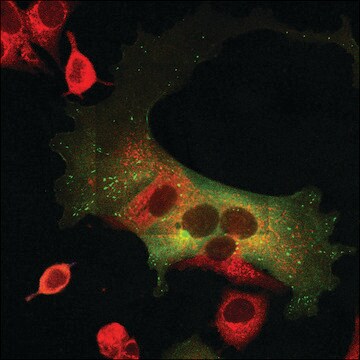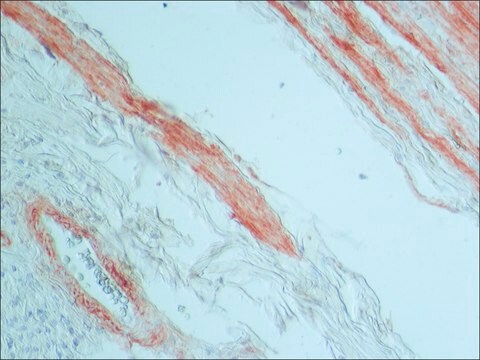推荐产品
生物源
mouse
品質等級
共軛
unconjugated
抗體表格
ascites fluid
抗體產品種類
primary antibodies
無性繁殖
BIII-136, monoclonal
包含
15 mM sodium azide
物種活性
human
技術
immunoprecipitation (IP): suitable using human erythrocytes
indirect immunofluorescence: suitable using methanol-fixed human erythrocytes
western blot: 1:5,000 using human erythrocytes
同型
IgG2a
運輸包裝
dry ice
儲存溫度
−20°C
目標翻譯後修改
unmodified
基因資訊
human ... SLC4A1(6521)
一般說明
Band 3 is a hydrophobic protein, it exists in erythrocytes as a dimer and tetramer and has a strong tendency to aggregate because of oxidative stress.
Band 3 is an anion exchanger that is abundantly found in erythrocyte membranes. This integral membrane anion exchanger protein regulates mechanical stability and ion homeostasis across the red blood cell membrane. Genetic alterations in Band 3 have been associated with familial distal renal tubular acidosis
Monoclonal Anti-Band 3 antibody detects Band 3 protein (90-100 kD) and several lower molecular mass peptides migrating in SDS-PAGE gels in the regions of 60, 40 and 20 kD. The product specifically binds to the cytoplasmic amino-terminal protein of band 3 (the epitope is approx. 20 kD from the N-terminal end). As the epitope is not located at the erythrocyte surface, the antibody product does not agglutinate red blood cells. Furthermore, its cell surface binding cannot be detected by an indirect agglutination assay. The antibody does not localize Band 3 from horse, bovine, pig, guinea pig, dog or mouse erythrocytes, nor does it localize Band 3 from nonerythroid human fibroblast extract.
Monoclonal Anti-Band 3 antibody detects Band 3 protein (90-100 kD) and several lower molecular mass peptides migrating in SDS-PAGE gels in the regions of 60, 40 and 20 kD. The product specifically binds to the cytoplasmic amino-terminal protein of band 3 (the epitope is approx. 20 kD from the N-terminal end). As the epitope is not located at the erythrocyte surface, the antibody product does not agglutinate red blood cells. Furthermore, its cell surface binding cannot be detected by an indirect agglutination assay. The antibody does not localize Band 3 from horse, bovine, pig, guinea pig, dog or mouse erythrocytes, nor does it localize Band 3 from nonerythroid human fibroblast extract.
特異性
The antibody recognizes an epitope located in the cytoplasmic N-terminus of the band 3 molecule/proteins (90-100kDa).
免疫原
Glycophorin B from human erythrocytes.
應用
Monoclonal Anti-Band 3 antibody can be used for western blot, immunoprecipitation and indirect immunofluorescence using human erythrocytes.
Monoclonal Anti-Human Band 3 has been used in immunoblotting. It may also be used in the study of red cell structures and functions and to study the fragmentation of the cytoplasmic domain of band 3 protein in vivo and in vitro.
Monoclonal anti-Band 3 antibodies can be used in ELISA and immunoprecipitation. It may also be used for immunofluorescent staining.
生化/生理作用
Band 3, a 90-100kD protein is the major integral protein of human erythrocytes responsible for anion exchange. It also regulates the intracellular pH. Monoclonal anti-Band 3 antibody is useful in in vivo and in vitro study of fragmentation of cytoplasmic domain of band 3 protein. It may also be used for immunoblot analysis. Monoclonal Anti-Human Band 3 antibody reacts specifically with cytoplasmic N-terminal band 3 proteins (90-100kD).
免責聲明
Unless otherwise stated in our catalog or other company documentation accompanying the product(s), our products are intended for research use only and are not to be used for any other purpose, which includes but is not limited to, unauthorized commercial uses, in vitro diagnostic uses, ex vivo or in vivo therapeutic uses or any type of consumption or application to humans or animals.
Not finding the right product?
Try our 产品选型工具.
儲存類別代碼
10 - Combustible liquids
水污染物質分類(WGK)
nwg
閃點(°F)
Not applicable
閃點(°C)
Not applicable
Antonella Pantaleo et al.
Oxidative medicine and cellular longevity, 2016, 6051093-6051093 (2016-04-02)
In erythrocytes, the regulation of the redox sensitive Tyr phosphorylation of band 3 and its functions are still partially defined. A role of band 3 oxidation in regulating its own phosphorylation has been previously suggested. The current study provides evidences
M Czerwiński et al.
European journal of biochemistry, 174(4), 647-654 (1988-07-01)
The mouse hybridoma monoclonal antibody BIII.136 of the IgG2a class is specific for human erythrocyte band-3 protein. It was shown by means of immunoblotting and immunoprecipitation assays that the antibody recognized an epitope located in the cytoplasmic pole of the
Daan Vorselen et al.
Nature communications, 9(1), 4960-4960 (2018-11-25)
Extracellular vesicles (EVs) are widely studied regarding their role in cell-to-cell communication and disease, as well as for applications as biomarkers or drug delivery vehicles. EVs contain membrane and intraluminal proteins, affecting their structure and thereby likely their functioning. Here
Mohammad Al-Ansari et al.
BMC hematology, 15, 17-17 (2015-12-22)
Glucose-6-phosphate dehydrogenase (G6PD) deficiency is associated with erythrocyte sensitivity to oxidative damage and hemolytic crises. In β-thalassemia major, where hemoglobin instability imposes oxidative stress, erythrocytes show reduced hENT1 nucleoside transporter expression and decreased nucleoside uptake. This study investigated hENT1 expression
E Lecarpentier et al.
PloS one, 11(1), e0147262-e0147262 (2016-01-28)
In the human placenta the maternal blood circulates in the intervillous space (IVS). The syncytiotrophoblast (STB) is in direct contact with maternal blood. The wall shear stress (WSS) exerted by the maternal blood flow on the STB has not been
我们的科学家团队拥有各种研究领域经验,包括生命科学、材料科学、化学合成、色谱、分析及许多其他领域.
联系技术服务部门








